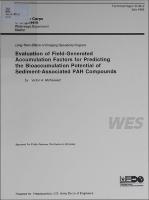Please use this identifier to cite or link to this item:
https://hdl.handle.net/11681/4860Full metadata record
| DC Field | Value | Language |
|---|---|---|
| dc.contributor | Northeast Louisiana University | - |
| dc.contributor | Long-Term Effects of Dredging Operations Program (U.S.) | - |
| dc.contributor.author | McFarland, Victor A. | - |
| dc.date.accessioned | 2016-03-18T12:20:31Z | - |
| dc.date.available | 2016-03-18T12:20:31Z | - |
| dc.date.issued | 1995-07 | - |
| dc.identifier.uri | http://hdl.handle.net/11681/4860 | - |
| dc.description | Technical Report | - |
| dc.description | Abstract: Equilibrium partitioning of neutral organic chemicals between the organic carbon fraction of bedded sediments and the lipids of resident organisms provides the theoretical basis for one of the most popular approaches to the development of sediment quality criteria (SQC) by the U.S. Environmental Protection Agency (EPA). The proposed equilibrium partitioning-based SQC seek to relate estimated doses of sediment-associated chemicals to toxicity in exposed biota. Criteria documents for several polynuclear aromatic hydrocarbon (PAH) compounds, endrin, and dieldrin have been released by the EPA for public review, and may soon be promulgated. A procedure recommended in the Implementation Manual (the "Green Book") for public law regulating ocean disposal of dredged sediments (Section 103, Public Law 92-532, Marine Protection, Research, and Sanctuaries Act, the "Ocean Dumping Act") has used equilibrium partitioning-based estimations to screen sediments for bioaccumulation potential for several years. The screening test, termed "theoretical bioaccumulation potential," TBP, is also included in the draft manual for inland waters to implement dredged material testing requirements of the Clean Water Act. TBP employs an accumulation factor (AF), defmed as the ratio at equilibrium of the organic carbon-normalized concentration of a neutral organic chemical in a sediment and the lipid-normalized concentration of the chemical in an exposed organism. The Green Book currently recommends using a universal AF = 4 for all neutral chemicals, the rationale being that this value is suitably protective of all neutral chemicals, provided certain caveats are recognized. This study compared the predictive capability of PAH AFs derived from field data with that of the universal AF = 4 in making TBP estimations. Predicted bioaccumulations using the two methods was compared with PAH tissue concentrations measured in laboratory exposures of clams (Macoma nasuta) and mussels (Mytilus edulis). NOTE: This.pdf file is large. Allow your browser several minutes to download the file. | - |
| dc.publisher | Environmental Laboratory (U.S.) | - |
| dc.publisher | Engineer Research and Development Center (U.S.) | - |
| dc.relation | http://acwc.sdp.sirsi.net/client/en_US/search/asset/1036342 | - |
| dc.rights | Approved for public release; distribution is unlimited. | - |
| dc.source | This Digital Resource was created from scans of the Print Resource | - |
| dc.subject | Accumulation factor | - |
| dc.subject | Bioaccumulation potential | - |
| dc.subject | Dredging | - |
| dc.subject | Dredging spoil | - |
| dc.subject | PAH | - |
| dc.subject | Polynuclear Aromatic Hydrocarbons | - |
| dc.subject | Polycyclic Aromatic Hydrocarbons | - |
| dc.subject | Sediments | - |
| dc.subject | TBP | - |
| dc.subject | Theoretical Bioaccumulation Potential | - |
| dc.subject | Marine sediments | - |
| dc.title | Evaluation of field-generated accumulation factors for predicting the bioaccumulation potential of sediment-associated PAH compounds | - |
| dc.type | Report | en_US |
| Appears in Collections: | Technical Report | |
Files in This Item:
| File | Description | Size | Format | |
|---|---|---|---|---|
| TR-D-95-2.pdf | 26.15 MB | Adobe PDF |  View/Open |